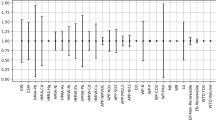Abstract
Some aspects of a number of different techniques for environmental decision support, in particular risk assessment (RA) and life-cycle assessment (LCA), are briefly discussed. The importance of a coherent framework, the use of common data sets, and harmonization of methods is emphasized. The latter leads to a discussion of a fundamental difference between techniques that assess continuous emission fluxes, like RA, and techniques that assess discrete emission pulses, like LCA. The question whether it is possible to apply the same types of impact assessment models is positively answered for most models. The implications are threefold: It is allowed to employ the much easier steady-state models in pulse-oriented techniques, there exist often postulated but not yet rigidly proven equivalency factors for use in e.g. life-cycle assessment, and it is possible to harmonize the models as used in pulse-oriented and in flux-oriented models.
Similar content being viewed by others
References
Ahlers, J., R. Diderich, U. Klaschka, A. Marschner &B. Schwarz-Schulz, 1994: Environmental risk assessment of existing chemicals. Environmental Science & Pollution Research 1: 2, 117–123.
Anonymous, 1989: Scientific assessment of stratospheric ozone. Volume I; report no. 20. WMO/UNEP, Geneva
Apostol, T.M., 1969: Calculus. Volume II. John Wiley & Sons, New York
Assies, J., 1994: Experts need ... experts (II). SETAC-Europe LCA news 4: 1, 5–6
Consoli, F., D. Allen, I. Boustead, J. Fava, W. Franklin, A.A. Jensen, N. de Oude, R. Parrish, R. Perriman, D. Postlethwaite, B. Quay, J. Seguin &B. Vigon, 1993: Guidelines for life-cycle assessment: a “Code of Practice”. Edition 1. SETAC, Brussels/Pensacola
Enquete Commission of the German Bundestag on the ‘Protection of humanity and the environment’ (Ed.): Responsibility for the future. Options for sustainable management of substance chains and material flows. Economica Verlag, Bonn 1994
Finnveden, G., 1993: Recent developments in methodologies for impact assessment in the context of life cycle assessment. IVL, Stockholm
Groot, S.R. De &P. Mazur, 1984: Non-equilibrium thermodynamics. Dover, New York
Guinée, J.B. &R. Heijungs, 1993: A proposal for the classification of toxic substances within the framework of life cycle assessment of products. Chemosphere 26: 10, 1925–1944
Heijungs, R., J.B. Guinée, G. Huppes, R.M. Lankreijer, H.A. Udo de Haes, A. Wegener Sleeswijk, A.M.M. Ansems, P.G. Eggels, R. van Duin &H.P. De Goede, 1992: Environmental life cycle assessment of products. Backgrounds — October 1992. CML, Leiden
Heijungs, R., 1994: A generic method for the identification of options for cleaner products. Ecological Economics 10, 69–81
Heijungs, R. &J.B. Guinée, 1994a: The flux-pulse problem in LCA. SE-TAC-Europe LCA news 4: 3, 6–7
Heijungs, R. &J.B. Guinée, 1994b: Using environmental multi-media models in LCA. The flux-pulseproblem. CML paper 18, Leiden
Howard, P.H., 1989: Handbook of environmental fate and exposure data for organic chemicals. Volumes I and II. Lewis Publ. Inc., Chelsea
Jager, D.T. &C.J.M. Visser, 1994: Uniform system for the evaluation of substances uses. Version 1.0. VROM, The Hague
Jänich, K., 1983: Analysis für Physiker und Ingenieure. Funktionentheorie, Differentialgleichungen, Spezielle Funftionen. Springer Verlag, Berlin
Jolliet, O., 1994: Critical surface-time. An evaluation method for LCA. p. 133–142. In:H.A. Udo de Haes, A.A. Jensen, W. Klöpffer &L.-G. Lindfors (eds.). Integrating impact assessment into LCA. SETAC, Brussels 1994
Kleijn, R., E. Van der Voet &H.A. Udo de Haes, 1994: Controlling substance flows. The case of chlorine. Environmental Management 18: 4, 523–542
Mackay, D., 1991: Multimedia environmental models, the fugacity approach. Lewis Publ. Inc., Chelsea
Mackay, D. &S. Paterson, 1991: Evaluating the multimedia fate of organic chemicals; a level III fugacity model. Environmental Science & Technology 25: 3, 427–436
Mackay, D., S. Paterson &W.Y. Shiu, 1992: Generic models for evaluating the regional fate of chemicals. Chemosphere 24: 6, 695–717
Perriman, R.J., 1995: Is LCA losing its way? SETAC-Europe news 5: 1 (1995), 4–5
Pesso, C., 1994: An overview of the life cycle approach to product/process environmental analysis and management. Draft. OECD, Paris
Udo de Haes, H.A. &G. Huppes, 1994: Positioning of LCA in relation to other environmental decision support tools, p. 17–22. In:H.A. Udo de Haes, A.A. Jensen, W. Klöpffer &L.-G. Lindfors (eds.). Integrating impact assessment into LCA. SETAC, Brussels 1994
Vermeire, T.G., M.E. van Apeldoorn, J.C. de Fouw &P.J.C.M. Janssen, 1991: Voorstel voor de humaan-toxicologische onderbouwing van C-(toetsings)waarden. RIVM, Bilthoven
Voet, E. van der &R. Heijungs. Life-cycle assessment and material balances. Different approaches? SETAC-Europe news 4: 6 (1994), 3–4
Author information
Authors and Affiliations
Rights and permissions
About this article
Cite this article
Heijungs, R. Harmonization of methods for impact assessment. Environ. Sci. & Pollut. Res. 2, 217–224 (1995). https://doi.org/10.1007/BF02986769
Received:
Accepted:
Issue Date:
DOI: https://doi.org/10.1007/BF02986769




